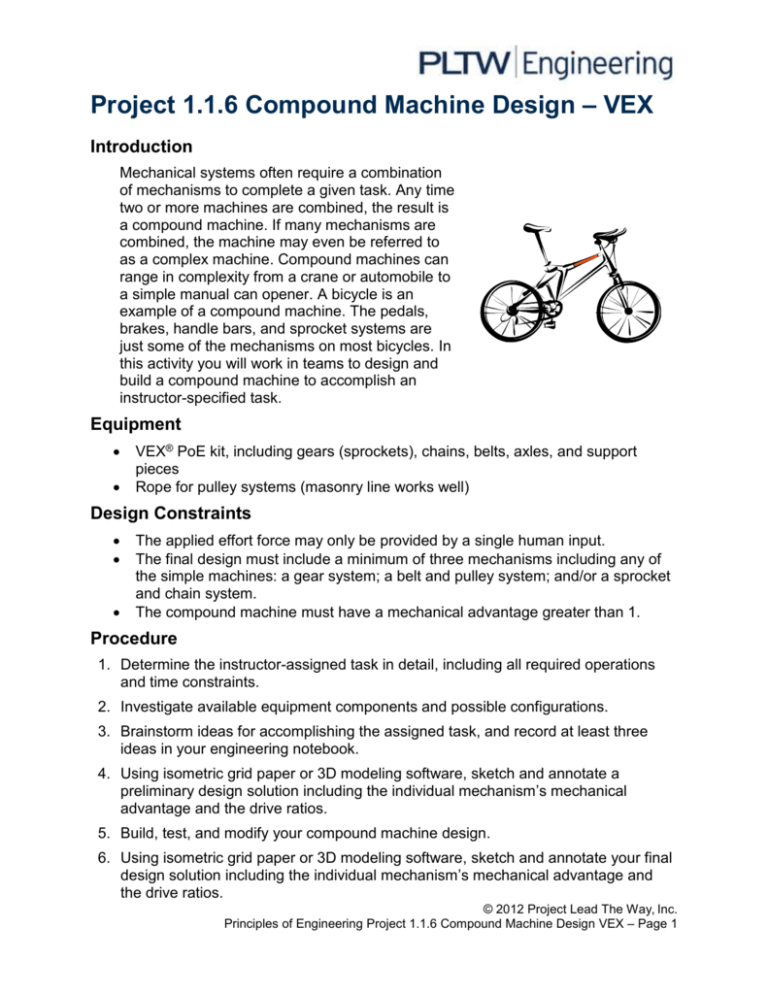Compound Machine Design Project - VEX Robotics
advertisement

Project 1.1.6 Compound Machine Design – VEX Introduction Mechanical systems often require a combination of mechanisms to complete a given task. Any time two or more machines are combined, the result is a compound machine. If many mechanisms are combined, the machine may even be referred to as a complex machine. Compound machines can range in complexity from a crane or automobile to a simple manual can opener. A bicycle is an example of a compound machine. The pedals, brakes, handle bars, and sprocket systems are just some of the mechanisms on most bicycles. In this activity you will work in teams to design and build a compound machine to accomplish an instructor-specified task. Equipment VEX® PoE kit, including gears (sprockets), chains, belts, axles, and support pieces Rope for pulley systems (masonry line works well) Design Constraints The applied effort force may only be provided by a single human input. The final design must include a minimum of three mechanisms including any of the simple machines: a gear system; a belt and pulley system; and/or a sprocket and chain system. The compound machine must have a mechanical advantage greater than 1. Procedure 1. Determine the instructor-assigned task in detail, including all required operations and time constraints. 2. Investigate available equipment components and possible configurations. 3. Brainstorm ideas for accomplishing the assigned task, and record at least three ideas in your engineering notebook. 4. Using isometric grid paper or 3D modeling software, sketch and annotate a preliminary design solution including the individual mechanism’s mechanical advantage and the drive ratios. 5. Build, test, and modify your compound machine design. 6. Using isometric grid paper or 3D modeling software, sketch and annotate your final design solution including the individual mechanism’s mechanical advantage and the drive ratios. © 2012 Project Lead The Way, Inc. Principles of Engineering Project 1.1.6 Compound Machine Design VEX – Page 1 7. Use the tables below to document and illustrate the mechanical advantage and drive ratios of the individual mechanisms utilized within your final compound machine solution. Show work and units throughout. Mechanism 1 Type Illustration: Include proper documentation such as force, distance, direction, and key mechanism features. Formula Mechanical Advantage / Ratio Calculations Substitute / Solve Final Answer Mechanism 2 Type Illustration: Include proper documentation such as force, distance, direction, and key mechanism features. Formula Mechanical Advantage / Ratio Calculations Substitute / Solve Final Answer Mechanism 3 Type Illustration: Include proper documentation such as force, distance, direction, and key mechanism features. © 2012 Project Lead The Way, Inc. Principles of Engineering Project 1.1.6 Compound Machine Design VEX – Page 2 Formula Mechanical Advantage / Ratio Calculations Substitute / Solve Final Answer 8. Calculate total/overall system mechanical advantage. Formula Substitute / Solve Final Answer Conclusion Questions 1. For which mechanism was it the easiest to determine the mechanical advantage or drive ratio? Why was it the easiest? 2. For which mechanism was it the most difficult to determine the mechanical advantage or drive ratio? Why was it the most difficult? 3. At what value would you estimate the input and output forces of your compound machine? How did you arrive at your estimated values? 4. What modifications could you make to your compound machine to make it more mechanically efficient? © 2012 Project Lead The Way, Inc. Principles of Engineering Project 1.1.6 Compound Machine Design VEX – Page 3








